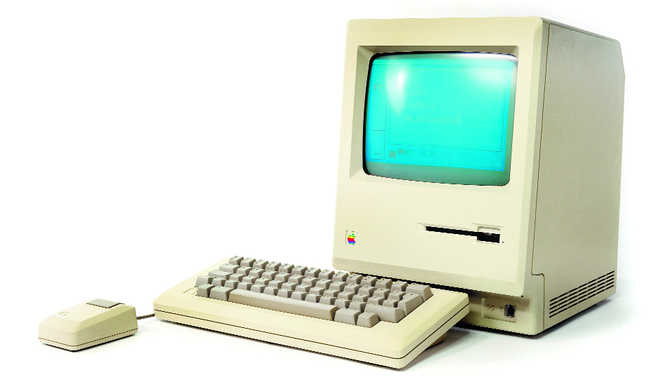
The Mac that became apple’s cheese: The Apple Macintosh 128k computer (1984) revived the company’s fortunes. iStock
Roopinder Singh
A coherent cacophony of creative minds of uncommon genius is how to best describe Adam Fisher’s first book. His byline is familiar, as have been his articles in Wired and the New York Times, but this, his first book, is a tour de force: a history of the creative fount that we now know as the Silicone Valley.
We are reacquainted with Doug Englebart, who in his 1968 ‘mother of all demos’ showed most of the elements of modern computing working together and laid the foundation on which Xerox and most memorably Apple, were to build on. Xerox had done all work in building Alto, a computerised office of the future. The close relationship between computers and videogames is sometimes ignored. It led to the creation of Atari, which ruled the gaming world, only to suffer mightily, when its corporatised management got out of sync with the engineers and programmers. It was rescued and put back on track, but failed to evolve and eventually sank in 1983 following the video game crash that brought down many giants. Atari was also where both the Steves, who founded Apple, worked before they branched out on their own.
Steve Jobs and Steve Wozniak made what became the world’s first mass-market personal computer — Apple II — in 1977. It sold 10 crore machines in its lifetime. The irony of it was that it was designed by Woz to play the game Breakout. Yet it became successful because the VisiCalc spreadsheet allowed businessmen to ‘play’ with numbers. When the 24-year-old Jobs saw Alto in 1979, he saw the mouse at work, along with a laser printer, networking, etc. He also saw the future of computing as a friendly device. Apple II was Steve Wozniak’s baby, and Jobs made Macintosh his. By 1993, IBM had introduced its personal computer, and Apple’s answer to that would be the ill-fated Lisa, and then, the Macintosh, launched with the memorable blockbuster 1984 Big Brother advertisement.
Machines were just one part of the equation. Software made the magic happen, and it was the bundling of Microsoft Office suite, along with a laser printer that transformed Macs from business machines to small publishing phenomena. Then came Wired, the first real magazine that chronicled the valley.
Versions of the Internet — the Well, CompuServe, AOL — existed since the mid-1970s, but it took a Mosaic improvement, Netscape, to make it accessible to the world. Jim Clark, a valley legend who had developed Mosaic, teamed with Mark Andreesen and made the browser that would make the world wide web accessible to, well, the world in 1994. And it made a ton of money for the company, at least for a while.
In came all kinds of things like eBay, search engines to navigate the Net, Napster, and then Google. The money was coming fast and furious ... it was all hunky dory till 2001 when the Silicone bubble burst and the dotcom boom ended, busting many companies. Among the almost-busted was Apple, but by 2000, Steve Jobs was fully in control, and reinvented the consumer electronics industry with the colourful iMac, iPod, and later iPhone, along with the traditional computers and laptops.
Google transformed search, and then how we interact with information. Facebook became the darling of connectivity, only to be tainted by its inability to police itself. Who could ever have thought that a US President would choose to communicate through Twitter’s staccato messages? The ever-evolving valley continues to be the creative capital of the cyber world, and this book, with its 200 interviews, provides voices that help us relate to a world that has shaped our interaction with the world at large. The author has chosen an unusual manner to relate the story of the valley’s primary players, and it works by democratising and deconstructing the narrative in a way that allows the reader to construct his own worldview. As Jamis McNiven, the valley’s bon vivant says: “Titans rise, titans fall — that’s the nature of the world. It just happens faster in Silicon Valley.”



























